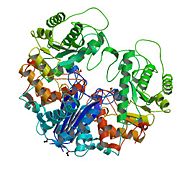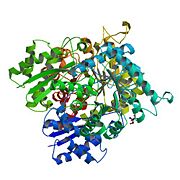Sandbox Reserved 455
From Proteopedia
| Line 14: | Line 14: | ||
Enolase has three subunits (α, β, and γ) and all of these subunits are usually found in vertebrates. Enolase α is ubiquitous, found in all cells, enolase β is muscle-specific, and the γ isozyme is found only in neurons.<ref>Stopped-flow studies of the reaction of d-tartronate semialdehyde-2-phosphate with human neuronal enolase and yeast enolase 1: http://www.sciencedirect.com.prox.lib.ncsu.edu/science/article/pii/S0014579310000657</ref> The subunits can combine in pairs (αα, αβ, αγ, ββ, and γγ) and form the five different isozymes of enolase. It is more common to find the homodimers (αα, ββ, and γγ) in adult human cells. The αα is called enolase 1, the ββ enolase 3, and the γγ enolase 2. Each homodimer still holds their original function: Enolase 1 is non-neuronal enolase (NNE), which is found in a variety of tissues, including liver, brain, kidney, spleen, adipose, enolase 3 is muscle specific enolase (MSE), and enolase 2 neuron-specific enolase (NSE). <ref name="enolase" /> | Enolase has three subunits (α, β, and γ) and all of these subunits are usually found in vertebrates. Enolase α is ubiquitous, found in all cells, enolase β is muscle-specific, and the γ isozyme is found only in neurons.<ref>Stopped-flow studies of the reaction of d-tartronate semialdehyde-2-phosphate with human neuronal enolase and yeast enolase 1: http://www.sciencedirect.com.prox.lib.ncsu.edu/science/article/pii/S0014579310000657</ref> The subunits can combine in pairs (αα, αβ, αγ, ββ, and γγ) and form the five different isozymes of enolase. It is more common to find the homodimers (αα, ββ, and γγ) in adult human cells. The αα is called enolase 1, the ββ enolase 3, and the γγ enolase 2. Each homodimer still holds their original function: Enolase 1 is non-neuronal enolase (NNE), which is found in a variety of tissues, including liver, brain, kidney, spleen, adipose, enolase 3 is muscle specific enolase (MSE), and enolase 2 neuron-specific enolase (NSE). <ref name="enolase" /> | ||
| - | NSE is the most abundant form of the glycolytic enolase found in adult neurons and is thought to serve as a growth factor in neurons. NSE is useful in studying neuronal differentiation and is, therefore, a valuable tool for visualizing the entire neuron and endocrine systems. <ref name="scripps">Neuron Specific Enolase: http://www.scrippslabs.com/cancer-markers-neuron-specific-enolase-nse/<ref> | + | NSE is the most abundant form of the glycolytic enolase found in adult neurons and is thought to serve as a growth factor in neurons. NSE is useful in studying neuronal differentiation and is, therefore, a valuable tool for visualizing the entire neuron and endocrine systems. <ref name="scripps">Neuron Specific Enolase: http://www.scrippslabs.com/cancer-markers-neuron-specific-enolase-nse/</ref> |
==Structure== | ==Structure== | ||
Revision as of 14:37, 8 May 2012
| This Sandbox is Reserved from 13/03/2012, through 01/06/2012 for use in the course "Proteins and Molecular Mechanisms" taught by Robert B. Rose at the North Carolina State University, Raleigh, NC USA. This reservation includes Sandbox Reserved 451 through Sandbox Reserved 500. | |||||||
To get started:
More help: Help:Editing For more help, look at this link: http://www.proteopedia.org/wiki/index.php/Help:Getting_Started_in_Proteopedia
Neuron Specific Enolase (Enolase 2)Introduction
 Biological Assembly Image for 1PDY Enolase [3] Enolase has three subunits (α, β, and γ) and all of these subunits are usually found in vertebrates. Enolase α is ubiquitous, found in all cells, enolase β is muscle-specific, and the γ isozyme is found only in neurons.[4] The subunits can combine in pairs (αα, αβ, αγ, ββ, and γγ) and form the five different isozymes of enolase. It is more common to find the homodimers (αα, ββ, and γγ) in adult human cells. The αα is called enolase 1, the ββ enolase 3, and the γγ enolase 2. Each homodimer still holds their original function: Enolase 1 is non-neuronal enolase (NNE), which is found in a variety of tissues, including liver, brain, kidney, spleen, adipose, enolase 3 is muscle specific enolase (MSE), and enolase 2 neuron-specific enolase (NSE). [1] NSE is the most abundant form of the glycolytic enolase found in adult neurons and is thought to serve as a growth factor in neurons. NSE is useful in studying neuronal differentiation and is, therefore, a valuable tool for visualizing the entire neuron and endocrine systems. [5] Structure Biological Assembly Image for 1TE6 Enolase 2 [6] Let's see how the text wraps Let's see how the text wraps Let's see how the text wraps Let's see how the text wraps Let's see how the text wraps Let's see how the text wraps Let's see how the text wraps Let's see how the text wraps Let's see how the text wraps Let's see how the text wraps Let's see how the text wraps Let's see how the text wraps MechanismLet's see how the text wraps Let's see how the text wraps Let's see how the text wraps Let's see how the text wraps Let's see how the text wraps Let's see how the text wraps Let's see how the text wraps Let's see how the text wraps Let's see how the text wraps Let's see how the text wraps Let's see how the text wraps Let's see how the text wraps MedicineLet's see how the text wraps Let's see how the text wraps Let's see how the text wraps Let's see how the text wraps Let's see how the text wraps Let's see how the text wraps Let's see how the text wraps Let's see how the text wraps Let's see how the text wraps Let's see how the text wraps Let's see how the text wraps Let's see how the text wraps References
|
